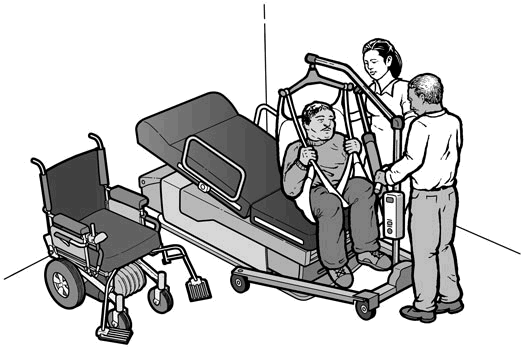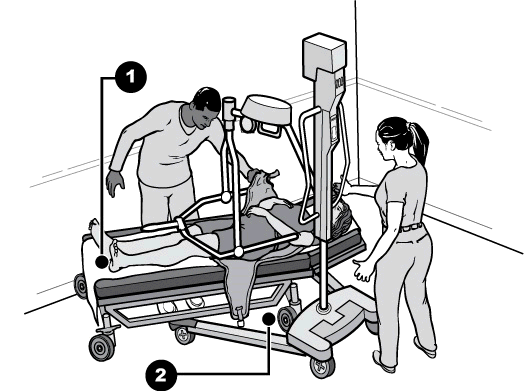Using Patient Lifts
Medical providers may need a lift in order to transfer some patients safely onto an exam table. Patient lifts may move along the floor or be mounted on an overhead track attached to the ceiling or to a free-standing frame. A staff person operates the lift. To use the lift, a sling is positioned under the individual while sitting in the wheelchair. Then the sling is attached to the lift so the staff person can move the individual to the examination surface. Once over the surface, the individual is lowered onto the table, stabilized, and then the sling is detached from the lift. The sling may remain under the patient during the exam or may be removed, depending on the exam. A variety of slings are available to provide different kinds of support.
Using lifts provides better security for the patient than being lifted by medical staff because there is less likelihood that the individual will be dropped or hurt in the process. Patient lifts also protect health care providers from injuries caused by lifting patients.
Portable Floor Lifts
The most common types of lifts in medical settings are portable with a U-shaped base that moves along the floor on wheels. These bases must go under, or fit around, the exam table in order to accomplish the transfer. A lift’s base may fit around the bottom end of an exam table, or fit fully or partially under the table at a perpendicular angle to the table. Some lifts are more easily operated by two or more people; others may be operated by one person. An advantage of a portable floor lift is that it can be moved from room to room and thus used with multiple exam tables. If a lift is used with multiple exam tables, the medical provider, depending on its size, may need to establish a procedure governing how the lift is shared and where it is stored. The provider should ensure that it does not schedule for the same appointment time more than one patient needing the lift. While these lifts may be less expensive than overhead lifts, they require more maneuvering space in the room and space for storage.
To properly and safely assist patients with transfers, medical staff will likely need training on how to operate the equipment and on safe patient handling techniques.

Assisted Transfer Utilizing a Portable Floor Lift
1. A low height, adjustable width base permits the lift to be positioned at the end of the examination table

Assisted Transfer Utilizing Both a Portable Floor Lift and Movable Exam Table
1.Movable exam tables allow additional flexibility to position table and lift for optimal patient transfer
2.Clearance beneath the exam table and an angled approach of the lift allows the patient to be positioned directly over the exam table for a safe transfer
Notes for Portable Floor Lifts:
- The amount of clear floor space needed to maneuver will depend on the type of floor lift equipment used.
- Portable floor lifts must be able to position the patient over the table surface; select a model that is compatible with the exam table and room configuration.
- A low height, adjustable width base can move closer to the end of the exam table and can be narrowed for transit and storage.

User Comments/Questions
Add Comment/Question